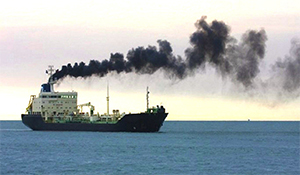The global shipping industry plans to cut greenhouse gas emissions by at least 50 percent over the next several decades as a step toward phasing them out entirely, according to a new strategy adopted by the International Maritime Organization (IMO).
The IMO’s action aims to align the industry with the international Paris Agreement to limit global temperature change. The agency’s Marine Environment Protection Committee (MEPC) adopted the strategy in April during a meeting in London attended by more than 100 IMO member states.
The goals are ambitious, requiring additional improvements in vessel technology and the development of fuels that emit no carbon dioxide (CO2).
“Ultimately the goal is to have carbonless fuels by the end of the century, and they’re counting on technology that hasn’t been developed yet,” said Kathy Metcalf, president and CEO of the Chamber of Shipping of America.
However, such aggressive targets may not have the full support of all industry players.
“Agreement upon a mid-century objective for the total reduction of CO2 emissions by the sector, regardless of trade growth, will be vital to discourage unilateral action and to provide the signal needed to stimulate the development of zero-CO2 fuels,” said Esben Poulsson, chairman of the International Chamber of Shipping (ICS). “But the very high level of ambition proposed by certain (European Union) member states — a 70 to 100 percent total cut in emissions before 2050 — is unlikely to achieve consensus support.”
The strategy outlines a framework for member states that identifies “levels of ambition” leading to the peak and eventual decline of greenhouse gas emissions — i.e., carbon dioxide — from international shipping. Overall, emissions from shipping have been projected to rise 250 percent by 2050 due to the increase in global commerce. Currently, vessels emit greenhouse gases on par with Germany, the sixth-largest emitter in the world.
The first level of the IMO plan aims to reduce carbon intensity through the Energy Efficiency Design Index (EEDI) for new ships. The second level calls for reducing CO2 emissions by at least 40 percent by 2030 and “pursuing efforts” toward 70 percent by 2050 using 2008 as a baseline. The third level calls for shipping to reach peak emissions as soon as possible and then reduce CO2 by 50 percent by 2050, with a goal of phasing out the use of CO2-emitting fuels completely.
These steps are in addition to previous efforts such as the adoption of energy-efficiency requirements for new and existing vessels. By 2025, new ships built will be 30 percent more energy efficient than those built in 2014, the IMO said. The mandatory collection of fuel-oil consumption data that began in March will guide future decisions as part of the three-step plan to reduce emissions.
Some countries, including China and Japan, have proposed alternatives with less aggressive targets in the interim while supporting the long-term goal of eliminating CO2 emissions by the end of the century, or whenever such fuels become available, the ICS said.
However, climate advocacy groups and island states most affected by rising ocean levels want a faster timetable to reduce the environmental impact from greenhouse gases.

